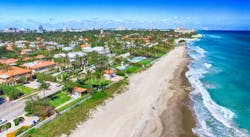Environmental Forecast: My 2019 Prognostications, and a Pulse Check
The new year will, in my humble opinion, be a mixture of both good and very bad news for the environment. Unfortunately, there will be more bad news than good.
In October 2018, we learned from the UN’s Intergovernmental Panel on Climate Change, that our adaptation strategies are a really short-term solution (a band aid, in the scheme of things), and that we needed to significantly ramp up our efforts on mitigation. Otherwise, the panel concluded, we would be in dire straits by as soon as 2030.
We also learned from the government’s quadrennial NCA4 report, released quietly on the Black Friday after Thanksgiving, that climate change isn’t just hurting our health and destroying our property. It’s also going to adversely affect our economic well-being as a nation (the silver lining in that cloud may be less climate change denial from the hard right). And if those two reports weren’t enough, we also learned last month that the rate of ice melting in Greenland has increased 500 percent since the Industrial Revolution, and that it’s continuing to accelerate. In 2019, we’re going to see even more alarming evidence of the changes in our climate, particularly as it affects sea level rise. (Since I live, work, and play in coastal South Florida, that concerns me a lot!)
The Race is On: Innovation v. Doom & Gloom
We’re also going to learn that our mitigation efforts are lagging behind and have not achieved the results that we hoped for. In other words, we’re still losing ground. Last month, in his December editorial, HPAC's Rob McManamy asked this question: Has the Green Building movement already won? My short answer: Hell, no! We haven’t even scratched the surface!
The only good news that I see is that climate-friendly technologies are improving. Many universities and research centers around the world are developing new energy-savings solutions on an almost daily basis. I’m expecting to see substantial improvements in cost-effective renewable energy products, particularly solar PV, and more innovative passive cooling and heating solutions.
A year ago, I made five predictions for trends to look for in 2018. And, after my dismal performance the previous year, I’m batting 1000 this time around! Here’s what I had said to look for in 2018:
- Climate change is only getting worse...
Unfortunately, I hit that one on the head, as noted above! - Greater focus on better water conservation...
That one, fortunately, was also a good call, although California’s droughts are still wreaking havoc there. Look for this trend to continue; - Even more higher efficiency HVACR products...
Join me in Atlanta this month for AHR Expo 2019 to see how successful our industry now is in developing higher efficiency products; - More 3D printing in construction (and everywhere else)...
Again, this was a good call. Manufacturers are now selling low-cost 3D printers and what began as a tool for rapid prototyping is becoming fully integrated into manufacturing and medicine. I look for much more 3D printing in 2019 as a service to an even wider range of consumers; - More clean energy financing.
In 2017, I reported that there were more than $340 million in commercial property-assessed clean energy (PACE) loans. Although the numbers for 2018 are not yet final, as of last August, CleanFund Commercial PACE Capital announced the closing of a securitization backed by $115 million of c-PACE assessments on 82 properties in six states, representing the largest c-PACE securitization to date. So, look for that trend to continue in 2019, as well... For more, watch this video...
A regular contributor to HPAC Engineering and a member of its editorial advisory board, the author is a principal at Sustainable Performance Solutions LLC, a south Florida-based engineering firm focusing on energy and sustainability.
About the Author
Larry Clark
A member of HPAC Engineering’s Editorial Advisory Board, Lawrence (Larry) Clark, QCxP, GGP, LEED AP+, is principal of Sustainable Performance Solutions LLC, a South Florida-based engineering firm focused on energy and sustainability consulting. He has more than two dozen published articles on HVAC- and energy-related topics to his credit and frequently lectures on green-building best practices, central-energy-plant optimization, and demand-controlled ventilation.
